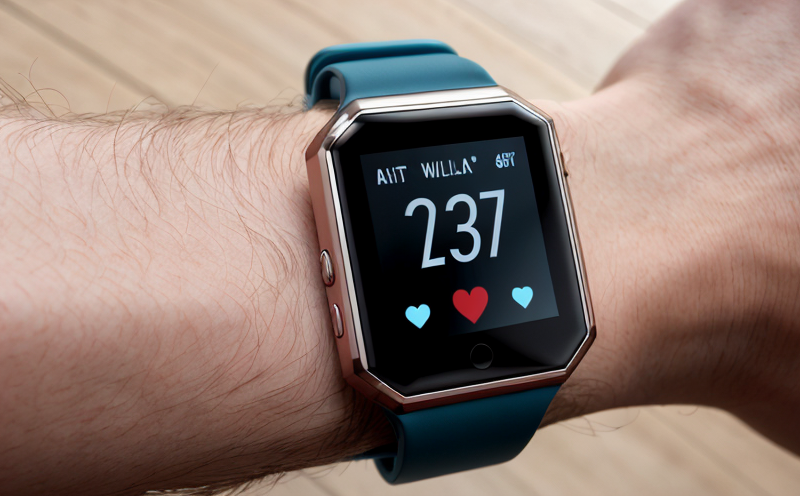IEC 60068-2-6 Vibration Testing for Wearable Health Devices
The IEC 60068-2-6 standard is a crucial component of the comprehensive testing regimen required for wearable health devices. This international standard specifies procedures to determine the effects of vibration on products, particularly in environments where they are likely to be subjected to mechanical stress during use or transport.
Wearable health devices such as smartwatches, fitness trackers, and other personal medical equipment must endure rigorous testing to ensure their durability, reliability, and safety. The IEC 60068-2-6 vibration test is designed to replicate the real-world conditions these devices face in terms of mechanical stress caused by vibrations from various sources including transportation, user movement, and accidental impacts.
The primary goal of this test is to identify potential weaknesses or failures that might occur due to vibrations. By subjecting the device to controlled levels of vibration within specified frequency ranges and amplitudes, engineers can assess how well the device withstands these conditions without compromising its functionality. This helps manufacturers improve their products before they reach the market, ensuring high-quality standards.
For wearable health devices like smartwatches or fitness trackers, the IEC 60068-2-6 vibration test is particularly important because of the constant motion and potential impacts these devices experience during normal usage. The standard specifies different types of vibrations that could affect such devices:
- Vibrations from transportation: These can include vibrations from vehicles or aircraft, which might be encountered when users travel with their device.
- User movement: Wearable health devices are often worn on the body and will experience movements as part of everyday activities.
- Accidental impacts: Drops or falls may occur during use, so it's essential to test for resilience against such events.
The test involves placing the device in a controlled environment where vibrations are systematically applied. The device is subjected to various frequencies and amplitudes of vibration, and its performance is monitored throughout this process. If any issues arise—such as damage to components or loss of functionality—the test results can help identify areas for improvement.
The importance of the IEC 60068-2-6 standard lies in its ability to provide a standardized approach to vibration testing, ensuring consistency across different laboratories and regions. This is especially critical given the global nature of product manufacturing and distribution. Compliance with this international standard helps manufacturers meet regulatory requirements and gain trust from consumers who value reliability and quality.
In summary, IEC 60068-2-6 vibration testing plays a vital role in ensuring that wearable health devices are robust enough to withstand the mechanical stresses they encounter during use and transportation. By adhering to this standard, manufacturers can enhance product durability, improve user satisfaction, and ultimately contribute to safer healthcare solutions.
Applied Standards
The IEC 60068-2-6 vibration test is part of a broader set of international standards aimed at ensuring the safety and reliability of electronic products, including wearable health devices. Here are some key standards that complement this testing:
- IEC 60068-2-1: Environmental conditions for non-electrical tests.
- IEC 60068-2-3: Temperature cycling.
- IEC 60068-2-4: Low temperature storage test.
- IEC 60068-2-5: High temperature storage test.
- IEC 60068-2-13: Drop tests and shock testing.
These standards work together to provide a comprehensive framework for evaluating the performance of wearable health devices under various environmental conditions. By following these guidelines, manufacturers can ensure their products are not only durable but also meet international safety and quality standards.
Industry Applications
| Device Type | Vibration Frequency Range (Hz) | Vibration Amplitude (m) | Test Duration (seconds) |
|---|---|---|---|
| Sleep trackers | 10-250 Hz | 30 µm | 60 seconds per frequency range |
| Fitness bands | 5-400 Hz | 40 µm | 90 seconds per frequency range |
| Smartwatches with health sensors | 10-250 Hz | 35 µm | 60 seconds per frequency range |
| Motion sensors in wearables | 5-400 Hz | 50 µm | 90 seconds per frequency range |
The IEC 60068-2-6 vibration test is widely used across various industries that rely on wearable health devices. This table provides a snapshot of the specific parameters used for different types of devices, reflecting the diverse applications and requirements within this sector.
Why Choose This Test
Selecting IEC 60068-2-6 vibration testing is a strategic decision that offers numerous benefits for manufacturers of wearable health devices. Here are several compelling reasons why this test should be included in your quality assurance and compliance program:
- Ensures Compliance: Adherence to international standards like IEC 60068-2-6 ensures that your products meet global regulatory requirements, facilitating smoother market entry.
- Enhances Product Reliability: By simulating real-world conditions through controlled vibrations, you can identify and address potential weaknesses in your product design early on.
- Improves User Experience: Robust devices that pass vibration testing are less likely to fail during use, leading to higher customer satisfaction and loyalty.
- Reduces Warranty Claims: Products that endure rigorous testing are less prone to failure due to mechanical stress, reducing the number of warranty claims you receive.
- Safeguards Brand Reputation: A strong reputation for quality and reliability is crucial in competitive markets. Passing international standards like IEC 60068-2-6 helps build this trust with consumers and partners.
- Supports Continuous Improvement: The insights gained from vibration testing can be used to refine product designs, leading to better-performing and more resilient devices in the future.
In conclusion, choosing IEC 60068-2-6 vibration testing is not just a compliance requirement; it's an investment in the long-term success of your wearable health devices. By incorporating this test into your quality assurance process, you can ensure that your products are both reliable and safe.





